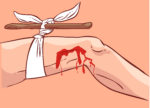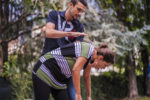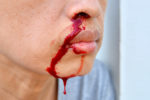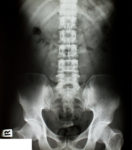If you do not have a commercial tourniquet, you can create improvised tourniquets using something flexible such as a triangular bandage, a scarf or a necktie. However, you should not use a thin flexible material such as a shoelace, string or a wire. If you were to use something like this, you may end up […]
Types of Fractures
Fractures can vary based on the nature of the break:
- Greenstick Fracture: A partial fracture where the bone bends and cracks on one side but doesn’t break completely. This type is common in children due to their more flexible bones. Learn more about greenstick fractures.
- Simple (Closed) Fracture: The bone breaks but doesn’t penetrate the skin.
- Compound (Open) Fracture: The broken bone pierces through the skin, increasing the risk of infection.
- Comminuted Fracture: The bone shatters into multiple pieces.
- Stress Fracture: A hairline crack in the bone often caused by repetitive stress or overuse.
Recognising the Symptoms
Common signs and symptoms of a broken bone include:
- Pain: Immediate and severe pain at the injury site.
- Swelling and Bruising: Inflammation and discoloration around the affected area.
- Deformity: The limb or joint appears out of place or misshapen.
- Inability to Move: Difficulty or inability to move the affected limb.
- Crepitus: A grating sensation or sound when the injured area is moved.
Immediate First Aid Steps
Prompt and appropriate first aid can prevent further injury and aid recovery:
- Ensure Safety: Before assisting, ensure the environment is safe for both you and the injured person.
- Immobilise the Injury: Keep the injured area as still as possible. Use a splint or sling to prevent movement. Learn how to apply a horizontal sling.
- Apply Cold Packs: Place ice wrapped in a cloth on the injury to reduce swelling and pain. Avoid placing ice directly on the skin.
- Elevate the Limb: If possible, raise the injured limb above heart level to minimise swelling.
- Seek Medical Attention: Contact emergency services or transport the person to a medical facility, especially if the fracture is severe or accompanied by heavy bleeding.
Special Considerations
Certain fractures require additional care:
- Spinal Injuries: If a spinal injury is suspected, avoid moving the person to prevent further damage. Instead, call emergency services immediately. Understand the spinal recovery position.
- Open Fractures: For fractures where the bone has pierced the skin, cover the wound with a sterile dressing without applying pressure directly on the protruding bone.
- Use of Tourniquets: In cases of severe bleeding that cannot be controlled with direct pressure, a tourniquet may be necessary. However, tourniquets should only be applied to limbs and require proper training to use effectively. Learn about the application of tourniquets.
Preventing Bone Injuries
While not all accidents can be prevented, certain measures can reduce the risk of fractures:
- Maintain Bone Health: Ensure a diet rich in calcium and vitamin D, and engage in regular weight-bearing exercises to strengthen bones.
- Use Protective Gear: Wear appropriate safety equipment during sports and high-risk activities.
- Ensure Safe Environments: Keep living and working spaces free from hazards that could cause trips or falls.
- Regular Check-ups: Routine medical examinations can help detect and address conditions that may weaken bones.
Further Resources
Expand your knowledge on bone injuries and first aid:
For comprehensive first aid training, consider enrolling in our First Aid at Work course.




